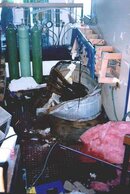jmneill
Contributor
Tanks do not burst from being overfilled... ever. A simple google search would prove that, and this discussion would now be over.
+1 !!! Reading this thread was painful.
Welcome to ScubaBoard, the world's largest scuba diving community. Registration is not required to read the forums, but we encourage you to join. Joining has its benefits and enables you to participate in the discussions.
Benefits of registering include
Tanks do not burst from being overfilled... ever. A simple google search would prove that, and this discussion would now be over.
Tanks do not burst from being overfilled... ever. A simple google search would prove that, and this discussion would now be over.
Tanks do not burst from being overfilled... ever. A simple google search would prove that, and this discussion would now be over.
My experience in filling is a bit different I guess.
That one has been debunked according to this: http://www.fillexpress.com/library/dryfills.pdf
Basically it states that the tank doesn't sit in the water long enough for it to have an impact on the temperature inside the tank.
As mentioned above, the article says repeatedly that a tank must never go above its rated pressure.I'm not a tank monkey, but from whatI've read an AL80 properly filled to 3000psi at 70f will raise to 3342 psi at 130f. This is quiet acceptable.
Here's some really good reading material on the subject:
http://www.fillexpress.com/library/dryfills.pdf
Since aire pressure will increase by 5-6 psi per degree temperature increase, if I increase temperature by say 100 degrees, I still only increase air perssure by 500 psi. Which for a standard AL 80 tank should be absolutely no problem.


Shops, for the most part, fill their tanks, with the tanks submerged in water. Any gas temperature rises, when the gas is compressed. When the tank is "on the rack" to be filled, there is a pressure gauge. This gauge is reading a "hot gas". So if the filler stops at 3000 psi, that is full - at that temperature.
Now, you take that tank, sometimes stored outside in 85 degree heat, in the sun, and it "reads" 3000 psi. True, enough, for that temperature (tank is probably 90+ degrees in the sun). But when you hit water that is 10-15 degrees cooler, the gas law kicks in that say the pressure is related to volume and temperature. The volume is the same (the 80 cubic foot tank), but the temperature has dropped. With the drop in temperature comes the drop in pressure.
Most shops (including the one where I teach), fill the tanks to around 3400-3500 "hot". The tanks then cool down to around 75 degees (over time, in the A/C), and read around 3000 to 3100 when renters pick them up.
Many "cattle car" boats will hot fill their tanks to only 3000 psi (if you were to read the temp of the air during a fill, it's over 120 degrees). But when the tanks cool down (when you hit the water), the pressure drops, often significantly. Part of this is by design (less time in the water).
Most liveaboards fill their tanks to around 3200-3300, directly out of the whips (nothing like a mad customer, over a period of days). These generally cool down to well over 3000 psi.
What I recommend if you do get a "short fill" is to simply swap the tank. If they are all short filled, I'd complain...because you didn't spend all that money to get to a dive location, then dive site, to have your u/w time cut by 20-25% because of a short filled tank. No excuse for that - ever.
Shops, for the most part, fill their tanks, with the tanks submerged in water.

as far as I can tell, it is and even if not, high school physics would show that they would have to ..That's assuming the tank ratings are designed to allow for the additional pressure caused by heat. How do you know that's the case? And if it is, how much heat is not too much heat? Shouldn't that be in the specs too then?
---------- Post added ----------
I do have technical knowledge about this. It's called high school physics. But just in case, they also teach Charles' Law in OWD courses, for the sole reason of trying to tell people not to let tanks heat up.
If we're going by fill pressure only, and not taking temperature into account, then if I cool my tank to 35f and have them top it off, it's not overfilled is it

